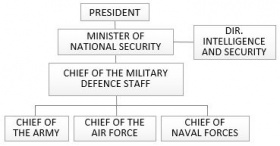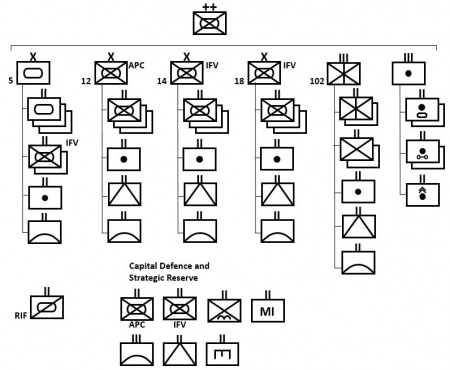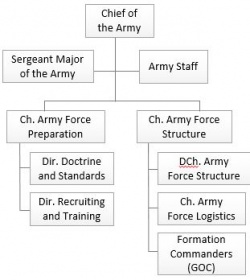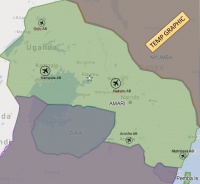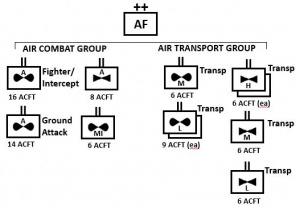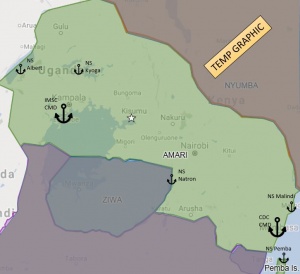Military: Ziwa
DATE Africa > Ziwa > Military: Ziwa ←You are here
The Ziwa People’s Defense Force (ZPDF) is the state military of the Republic of Ziwa. Its structure and focus has adapted over the last decade alongside the country’s economic development. The ZPDF consists of the Ziwa Ground Forces Command (ZGFC), Ziwa Air Corps (ZAC), and the National Guard. Ziwa’s military relations with its neighbors – Amari to the north and Kujenga to the south - is generally stable, despite sporadic low-level incidents along the border. The scope of border control operations has contributed to the forward deployment of dedicated maneuver elements and leveraging of former rebels to ensure the appearance of security.
Multiple threats exist to exploit Ziwa’s dependency on natural resources and external power generation and transmission. Brutal militants in the northeast mountain area (“The Watasi Gang”) and pockets of ethnic rebels throughout the country continue to plague stability and keep the military at continually high operational tempo. Although both Kujenga and Amari have active security agreements with Ziwa, rumors persist of covert support to the rebels by both countries. Another key role of the ZPDF is support to reducing criminal smuggling and trafficking of arms and humans through the country’s borders. The ZGFC and National Guard both have resources dedicated to this task. Defense spending and percentage of GDP included over the last five years averaged 1% of GDP. (Figures from CIA World Factbook.)
| Ziwa | Kujenga | Nyumba |
|---|---|---|
|
|
|
Ziwa National Command Authority
Military branches of the Ziwa People’s Defense Force (ZPDF) receive their authority via a civilian control and structure. The Ziwan Ministry of Security and Defense (MoSD) exercises overall control of the application of all instruments of national power to plan and carry out the national security strategy.National Strategic Goals
Ziwa’s defense policy has evolved from the previous regime’s emphasis on the need to defend itself against any external aggression. Over the last two decades it has also recognized that the threat to a country’s stability and economic progress can be internal. The mission of a nation’s security and defense forces are to ensure security by effectively implementing the nation’s policies on internal and external security. Its experience in suppressing rebellion within its borders led to internal defense policies that have been criticized for complying with only the letter of international agreements. Ziwa believes its economic progress, political power, and regional prestige are imperiled without a modern military power to secure them. The forces are designed and structured with these objectives in mind:
- Maintain internal stability and prevent internal security issue from destabilizing political and economic gains
- Support regional cooperation and develop stable international military relations
- Ensure and support beneficial use of Ziwan land and lake resources
- Enforce territorial integrity and maintain border security
- Defeat armed militants that threaten internal security and inhibit free trade and tourism.
Security and defense policy dictates that the forces should be held in operational readiness and their organization, equipment and procedures for exercising command and control should be tailored towards meeting the role and missions of the forces in peacetime, national emergency or crisis and in war.
Ziwa’s military forces must be used to influence perceived potential threats across the borders or otherwise. Modernizing and updating of the forces to cater for contingencies is essential and an ongoing program across all services.
Ziwa Ground Forces Command (ZGFC)
The Ziwa Ground Forces Command (ZGFC) is responsible for all ground combat and security patrol operations. Generally regarded as a competent ground force when conducting operations, military units in garrison have sometimes reflected their government’s level of corruption. There are approximately 33,600 ground forces on active duty, including the National Guard. No formal reserve capability exists. Forces are generally arrayed in rotation along Ziwa’s borders with non-deployed forces remaining in garrison bases.
Doctrine and Tactics
Ziwan military doctrine in similar to that of its neighbor, Kujenga, in that forces are deployed to stabilize and respond to security incidents. Heavier maneuver forces and/or air support may then be deployed to augment in-contact forces and provide decisive engagement as needed. While Ziwa has a fairly capable array of ground assets, commanders prefer to leverage their robust indirect fire capabilities – particularly in sparsely-populated areas.
Ziwan ground forces have modernized to a point, but their command doctrine retains legacy elements from prior to the force restructuring of the last two decades.
Composition
Maneuver battalions are Ziwa’s basic combat unit, with most being able to operate semi-independently. The ZGFC routinely adjusts its task organization based on mission requirements or perceived changes to threat conditions. The motorized regiments are rotated to designated security missions, with heavy forces and artillery allocated per mission requirements. The remainder of the forces are generally maintained at installations near Usagara and Geita.Primary Formations:
- 7th Mechanized Brigade
- 1st Motorized Regiment
- 2nd Motorized Regiment
- 26th Artillery Regiment
- 27th Rocket Regiment
- 22nd Air Defense Regiment
- 1st Information Warfare Battalion
- 356th Engineer Battalion
- 51st Antitank Battalionn
Paramilitary Forces
YOU STOPPED HERE (minus graphics) Border Guard Corps (BGC). The BGC is a national security and paramilitary unit of the ANDF and functions as the primary law enforcement body outside of the well-policed urban areas. They are administratively under the Ministry of Revenue, but are under operational control of the Amari Army. The BGC’s primary roles are border control operations and combating crime cross-border trafficking and other transient criminal activities. They are primarily utilized to augment police at elevated-risk inspections at customs stations and to supplement infantry forces along the border. They may also be used to supplement infrastructure critical assets protection. Soldiers leaving active duty with regular units often transfer to the BGC rather than to the reserve rolls.
Special Reserve Force (SRF). SRF personnel are elite police/paramilitary soldiers. Their most significant roles are to conduct special operations, riot control, and counter-terrorism. They may be used independently or in conjunction with regular military operations. They routinely train and deploy with elements of the Airborne Battalion and the Air Force to conduct operations in remote areas. They enjoy more advanced equipment (niche Tier 1) and better funding than other Amari forces.
Defence Force Reserves. The ANDF reserve component is manned with a voluntary national service system. Through this system, volunteers receive a basic military-style familiarization training and have the option to receive additional training and transfer to the regular forces. Reserve formations are aligned either with regular units or military district. They are mostly used for civil emergency defense.
(See also TC 7-100.2: Opposing Force Tactics, Chapter 15, Special Purpose Forces and Commandos.)
Training and Readiness
Amari fields the one of the best-trained and most professional military forces in the region. The Defense Ministry’s training branch manages training courses for officers and enlistees throughout their respective career paths. Unit training is managed by unit commanders. Most units maintain a 75% operational readiness rate.
Most military training is conducted at the Kalama Military Academy near Kambaba. Its Manoeuver Warfare Training Center (MWTC) hosts all services and foreign training personnel. Paramilitary forces have their own training departments, but share many of the same courses as the Army at the MWTC. Amari’s paramilitary forces maintain their training and readiness on a par with their Army counterparts.
Amari’s push for integrated (ethnic, gender, tribal) forces and training increased its flexibility and reduced professionalism problems experienced by some of its regional neighbors. Intentional integration of paramilitary and reserve forces into regular military training and schools further developed the overall professionalism of the force.
Amari retains a reserve recall capability of former soldiers for five years after leaving active duty, but has never activated it. If activated, it adds approximately 12,000 troops to current army strength levels. The capability of these reserves troops varies greatly; they will most likely back-fill gaps in non-combat positions. Amari currently does not have a compulsory service requirement or draft.
Weapons and Equipment
Amari ground forces’ equipment and weapons largely reflect a mix of Tier 2 and Tier 3 capabilities with limited Tier 1 niche capabilities, although budget constraints and shifting political environments threaten to allow stocks to age. The Amari inventory is a mix of equipment from Russia/USSR, China, Namibia, and the UK. The Special Reserve Force (SRF) enjoys the best and most modern equipment (Tier 1-2), while the Border Guard Corps (BGC) and some infantry units largely have Tier 3 inventories. The Amari army has the equipment to operate in all terrain types and successfully conduct both day and night operations.
Functional Capabilities
Command and Control
The Amari military maintains a constitutionally-mandated civilian control and structure. It has developed a high degree of trust across all echelons. Professional military training filled its ranks with competent leaders who can operate independently.Amari is keenly aware of potential threats to its command and control (C2) capabilities and has worked to mitigate such threats by decentralizing wherever viable. Despite this effort, their communications and networks may yet be vulnerable to attack and/or surveillance.
C2 at the tactical level emphasizes survivability through mobility, communications redundancy, and rigorous operations security. Command posts and procedures are streamlined at the operational level, relying heavily on common procedures for important recurring tactical tasks.
(See also TC 7-100.2: Opposing Force Tactics, Chapter 2, Command and Control)
Maneuver
The Amari military has a robust capability to conduct combined arms operations. Maneuver brigades serve as Amari’s basic combined arms unit. The major maneuver units of the ANDF are administratively aligned along their historical regimental affiliations, but in practice are task organized and deployed based on operational requirements. Units can organize into special purpose task forces, designed to accomplish independent missions without further allocation of forces from a higher-level headquarters.
The military districts usually rotate forces between forward and supporting roles. This provides a consistent defensive posture while allowing for rapid response to potential threats. Forces may also provide support outside of their assigned district as needed.
The Amari National Defence Force structures its maneuver brigades to provide maximum flexibility. Maneuver battalions are organized to conduct operations independently or as part of a task-organized brigade tactical group (BTG). In rare situations that require formations larger than brigade, the National Defence Chief will designate a task force and appoint its commander.
Air Defense
Air defense in Amari is an all unit, all-arms effort. All ground units possess organic air defense capabilities to differing degrees, depending on the type and size of the unit. Maneuver and paramilitary forces are trained to use organic direct fire systems, such as heavy machine guns and even some anti-tank guided missiles, in an air defense capacity.
Amari also has a dedicated air defense regiment that is responsible for larger systems and point defense. Air defense batteries are often task organized to maneuver units.
Amari has significantly developed its integrated air defense system (IADS), which includes automated and semi-automated linkage of air defense assets and surveillance systems throughout the force. This capability provides a continuous and overlapping umbrella of coverage and presents a significant defense against most potential enemy air activity.
(See also TC 7-100.2: Opposing Force Tactics, Chapter 11, Air Defense)
INFOWAR
Amari defines information warfare (INFOWAR) as specifically planned and integrated actions to achieve an information advantage at critical points and times. The goal of Amari INFOWAR is to influence a threat actor’s decision-making cycle through collected and available information, information systems, and information-based processes, while retaining the ability to employ friendly information and information-based processes and systems.
Defense against GPS jamming and spoofing is a serious concern for the Amari due to the number of key systems dependent on GPS – particularly advanced targeting and UAV capabilities. Amari has not publicly discussed any potential offensive GPS-affecting capabilities. Regular forces are becoming more accustomed to operating in communication-degraded environments, but may still be vulnerable to GPS interference.
Amari has developed a robust defensive cyber operations (DCO) capability in response to intrusion by international and regional hostile actors. Amari reportedly has well-developed offensive cyber operations (OCO) and cyber operational preparation of the environment (cyber OPE). Cyber operations, other than tactical active and passive protective measures, are managed by the Directorate of Intelligence and Security. The MOD may allocate resources as needed to tactical commanders.
(See also TC 7-100.2: Opposing Force Tactics, Chapter 7, Information Warfare )
RISTA
Reconnaissance, intelligence, surveillance, and target acquisition (RISTA) is one of the most important enabling functions of the Amari military. Amari ground commanders use these capabilities to aggressively gain understanding with overlapping redundancy in the intelligence disciplines.
A significant emphasis of Amari RISTA forces is enabling commanders’ understanding of the human, information and physical aspects of the environment by collecting, processing and disseminating information and intelligence required. Amari RISTA elements are fully capable of conducting both reconnaissance and surveillance tasks. These elements’ composition varies according to the supported maneuver commander’s requirements. They may also conduct operations independent of a supported command. Although these elements generally avoid armed contact and detection, reconnaissance forces, when supported by fires, can provide guards and screens, or be used to degrade enemy ISR capabilities or conduct limited counter-reconnaissance.
Amari invested heavily in unmanned aircraft from a variety of suppliers and allocates them down to the lowest echelon as possible. Most maneuver units and many border elements have demonstrated effective use of the UAV to supplement human and electronic surveillance.
Amari has developed a significant aerial intelligence capability, including support from the Navy assets and space-based capabilities. Amari also maintains intelligence sharing agreements with Ziwa.
Fire Support
Amari military doctrine stresses that fire support combines air assets, surface-to-surface missiles, and artillery into an integrated attack against enemy defenses as well as for offense operations. Amari capability in this area was proven during numerous peacekeeping deployments. Technical enhancements will likely increase the accuracy and integration of the entire spectrum of fire support systems. The majority of the indirect fire systems are towed and have dedicated prime mover and support vehicles.
(See also TC 7-100.2: Opposing Force Tactics, Chapter 9, Indirect Fire Support)
Protection
Military engineer elements are highly capable. They are well-integrated into maneuver units and have supported border efforts to reduce unauthorized crossing. In times of conflict, mobility assets may surge to support repositioning of heavy maneuver elements. Amari engineer capabilities have been leveraged in peacekeeping and humanitarian assistance deployments. Amari will attempt to minimize civilian casualties and collateral damage as much as possible: C2 and related systems are generally sufficient to prevent unintended casualties and damage.
(See also TC 7-100.2: Opposing Force Tactics, Chapter 12, Engineer Support)
Logistics
The Amari military maintains a robust domestic logistics capability that can support its maneuver units for extended periods. As deployment requirements expanded, Amari invested in additional airlift and sea-borne transport capabilities. Amari’s military continues to improve its logistics systems, including increased emphasis on regional support stockpiles in each military district.
Other missions include mobilization control, in-country movement and life support tasks (for example, reception, staging and onward integration), force supply and distribution, the reverse supply chain, contractor support and personnel policy. Tactical level logistic, equipment, health services, infrastructure and administrative support are normally conducted by the individual components, but require coordination across the wider joint operations area.
CBRNE
Amari does not have an offensive CBRNE capability, nor is it part of their warfighting doctrine. All units receive defensive training and have a basic chemical defense capability. Emergency responders in all cities have more advanced capabilities for mass casualty care.
Amari Air Force
The Amari Air Force (AAF) is capable of supporting ground combat and defensive air operations. Its roles include air-to-air, ground attack, and transportation. It has also been used to support peacekeeping deployments in all of these roles. It is well-integrated into ground force operations and it well suited for defensive operations and support to limited force projection.
Air Force Size and Structure
The Amari Air Force fields an estimated 50-60 fixed wing aircraft and 30-40 helicopters. The Amari air force operates primarily from bases in Kampala and Nakuru, but also maintains smaller bases collocated at the civilian airfields in Gulu, Arusha, and Mombasa. The Air Force also maintains a presence at Kisumu International Airport. The Minister of Defence may authorize air force use of any Amari civilian airfield, as military requirements demand.Air Force Doctrine and Tactics
The Amari air force stations most of its aircraft and support assets at the two main bases, preferring to push capabilities as requirements dictate. It routinely flies supply and training missions throughout the country to enhance readiness. This also increase its ground support responsiveness and agility. If crisis situations arise, they may push a response and support package to a more forward airfield.
Air Force Weapons and Equipment
The Amari air force operates equipment and weapons based on technology from 10 to 20 years ago to create a Tier 2 capability rate. Some of the aircraft have been fitted with niche Tier 1 equipment that provide advanced capabilities, such as surveillance and targeting. The Amari air force can conduct 24-hour operations in all weather and over all terrain. The Amari aircraft inventory includes equipment from USA, Canada, and Spain/Indonesia.
Air Combat Group:
- Fighter/Intercept SQDN
- Ground Attack SQDN
- Attack Helicopter SQDN
- Intelligence and Surveillance SQDN
Air Transport Group
- Medium Air Transport SQDNs
- 2x Light Air Transport SQDNs
- Medium Helicopter Transport SQDNs
- 3x Light Helicopter Transport SQDNs
Air Force Training and Readiness
Due to its small size and large operational budget as compared to the other services, the Amari air force maintains a high level of training and a 80% operational readiness rate. Amari pilots receive significant annual flight hours and have earned a solid international reputation on both air-to-air and air-to-ground missions. Most pilots are trained to provide close air support, aided by linked ground location tracking systems. In addition to the traditional roles of the Amari air force, they consistently train on dynamic mission re-tasking.
The Amari Navy (AN) has military responsibility for the Amari maritime security along its eastern coastline and on Lake Victoria. Amari's maritime force is large compared to its neighbors, yet still retains a high level of agility and capability. Amari maritime operations have evolved to be very similar to others in the region, focusing on coastal and inland defense with moderate force projection capabilities. Their doctrine centers on defense with a heavy emphasis on securing the coastal areas and protecting commercial traffic and resource shipping from smugglers and pirates.
The Amari policy of aggressive confrontation of smugglers and pirates has largely been applauded, but several incidents involving misidentification have led to tragedy and international protest. This has led to ongoing tensions in the waters between the mainland and Pemba Island and the Pemba Islanders.
Amari naval missions include:
- Patrolling and defense of coastal areas
- Lake and inland waterway security
- Support to peacekeeping
- Combating maritime crime, smuggling, and piracy
- Supporting humanitarian assistance and disaster relief
- Combating threats to the environment
- Maritime and aerial surveillance
- Search and rescue
- Assisting the Ministry of Agriculture, Livestock, and Fisheries
- Protecting offshore resources
The Amari naval headquarters is collocated with its Coastal Defence Group in Mombasa. The Amari Navy divides maritime security responsibilities into two commands:
Coastal Defence Group. The Amari Coastal Defence Group has responsibility for maritime operations along the coast, Pemba Island, and territorial waters. It maintains bases near Mombasa and Malindi, with several smaller stations, with a detachment on Pemba Island (Pemba Naval Station).
Inland Maritime Security Group. The Amari Inland Maritime Security Group has responsibility for maritime security operations of Amari waters on Lake Victoria and Lake Albert. It also maintains small detachments on Lake Natron and Lake Kyoga for mostly environmental protection. It is headquartered near Entebbe.
The AN fields largely tier 2 equipment and weapons with limited Tier 1 niche capabilities financed largely through regional security agreements and sale of natural resources.
Amari naval equipment focuses on defensive operations, especially the defense of off-shore resources and infrastructure. Amari will continue to purchase equipment such as minesweepers, increase Special Operations capabilities, and improve amphibious assault capabilities. The AN can operate in all sea conditions and can successfully conduct 24-hour operations.
The AN possesses 30-35 surface craft and reportedly 2 submarines. It operates a variety of surface combatants, patrol boats, minesweepers, and amphibious elements. The AN also fields a small naval special operations forces (SOF).
Elements of the 102nd Infantry Regiment or the Reconnaissance and Intelligence Formation may be attached to support naval requirements as needed
Amari Naval Inventory:
- 4x Frigates
- 2x Corvettes
- 6x Patrol/Strike/OPV/IPV
- 6x Coastal/River defense
- 9x River/Lake Defense
- 2x Minesweepers
- 4x Amphibious assault
- 2x Submarines
While the AN went through a significant downsizing over the last decade, the reinvigorated emphasis on countering piracy and other maritime crime has increased its operational readiness to approximately 80%. It has a well-trained and motivated force, due mostly to a comprehensive training and professional development program, supported with international trainers.
| DATE Africa Quick Links . | |
|---|---|
| Amari | Political • Military • Economic • Social • Information • Infrastructure • Physical Environment • Time |
| Kujenga | Political • Military • Economic • Social • Information • Infrastructure • Physical Environment • Time |
| Nyumba | Political • Military • Economic • Social • Information • Infrastructure • Physical Environment • Time |
| Ziwa | Political • Military • Economic • Social • Information • Infrastructure • Physical Environment • Time |
| Other | Non-State Threat Actors and Conditions • Criminal Activity • DATE Map References • Using The DATE |

